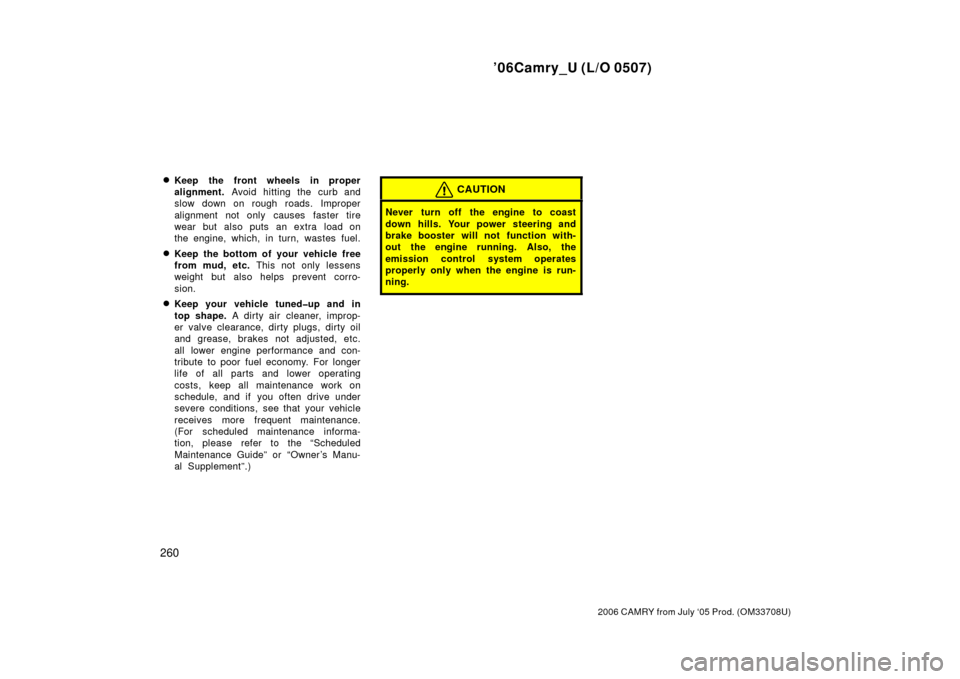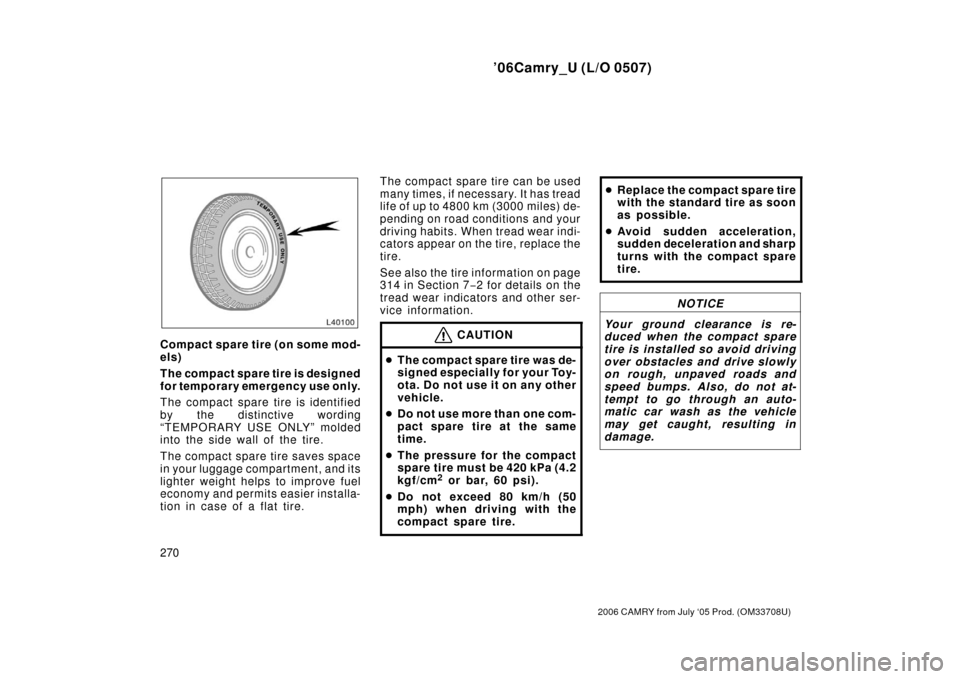Page 268 of 357

’06Camry_U (L/O 0507)
260
2006 CAMRY from July ‘05 Prod. (OM33708U)
�Keep the front wheels in proper
alignment. Avoid hitting the curb and
slow down on rough roads. Improper
alignment not only causes faster tire
wear but also puts an extra load on
the engine, which, in turn, wastes fuel.
�Keep the bottom of your vehicle free
from mud, etc. This not only lessens
weight but also helps prevent corro-
sion.
�Keep your vehicle tuned�up and in
top shape. A dirty air cleaner, improp-
er valve clearance, dirty plugs, dirty oil
and grease, brakes not adjusted, etc.
all lower engine performance and con-
tribute to poor fuel economy. For longer
life of all parts and lower operating
costs, keep all maintenance work on
schedule, and if you often drive under
severe conditions, see that your vehicle
receives more frequent maintenance.
(For scheduled maintenance informa-
tion, please refer to the “Scheduled
Maintenance Guide” or “Owner ’s Manu-
al Supplement”.)
CAUTION
Never turn off the engine to coast
down hills. Your power steering and
brake booster will not function with-
out the engine running. Also, the
emission control system operates
properly only when the engine is run-
ning.
Page 278 of 357

’06Camry_U (L/O 0507)
270
2006 CAMRY from July ‘05 Prod. (OM33708U)
Compact spare tire (on some mod-
els)
The compact spare tire is designed
for temporary emergency use only.
The compact spare tire is identified
by the distinctive wording
“TEMPORARY USE ONLY” molded
into the side wall of the tire.
The compact spare tire saves space
in your luggage compartment, and its
lighter weight helps to improve fuel
economy and permits easier installa-
tion in case of a flat tire.The compact spare tire can be used
many times, if necessary. It has tread
life of up to 4800 km (3000 miles) de-
pending on road conditions and your
driving habits. When tread wear indi-
cators appear on the tire, replace the
tire.
See also the tire information on page
314 in Section 7−
2 for details on the
tread wear indicators and other ser-
vice information.CAUTION
� The compact spare tire was de-
signed especially for your Toy-
ota. Do not use it on any other
vehicle.
� Do not use more than one com-
pact spare tire at the same
time.
� The pressure for the compact
spare tire must be 420 kPa (4.2
kgf/cm
2 or bar, 60 psi).
� Do not exceed 80 km/h (50
mph) when driving with the
compact spare tire.
�Replace the compact spare tire
with the standard tire as soon
as possible.
� Avoid sudden a cceleration,
sudden d eceleration and sharp
turns with the compact spare
tire.
NOTICE
Your ground clearance is re-
duced when the compact spare
tire is installed so avoid driving
over obstacles and drive slowly
on rough, unpaved roads and
speed bumps. Also, do not at-
tempt to go through an auto-
matic car wash as the vehicle
may get caught, resulting in
damage.
Page 323 of 357

’06Camry_U (L/O 0507)
315
2006 CAMRY from July ‘05 Prod. (OM33708U)
Keep your tire inflation pressures
at the proper level.
The recommended cold tire inflation
pressures, tire sizes and the com-
bined weight of occupants and cargo
(vehicle capacity weight) are de-
scribed on page 336 and 340. They
are also on the tire and loading infor-
mation label.
You should check the tire inflation
pressure every two weeks, or at least
once a month. And do not forget the
spare! The following instructions for
checking tire inflation pressure
should be observed:
� The pressure s hould be
checked only when the tires are
cold. If your vehicle has been
parked for at least 3 hours and has
not been driven for more than 1.5
km or 1 mile since, you will get
an accurate cold tire inflation pres-
sure reading.
� Always use a tire pressure
gauge. The appearance of a tire
can be misleading. Besides, tire
inflation pressures that are even
just a few pounds off can degrade
ride and handling.
� Take special care when adding
air to the compact spare tire.
The smaller tire size can gain
pressure very qu ickly. Add com-
pressed air in small quantities and
check the pressure often until it
reaches the specified pressure. �
Do not bleed or reduce tire
inflation pressure after driving.
It is normal for the tire inflation
pressure to be higher after driving.
� Never exceed the vehicle capac-
ity weight. Passenger and lug-
gage weight should be located so
that the vehicle is balanced.
Page 326 of 357

’06Camry_U (L/O 0507)
318
2006 CAMRY from July ‘05 Prod. (OM33708U)
If air loss occurs while driving, do not
continue driving. Driving even a short
distance can damage a tire beyond
repair.
An y ti res wh i ch are over 6 years
old must be checked by a qualified
technician even if damage is not
obvious.
Tires deteriorate with age even if they
have never or seldom been used.
This applies also to the spare tire and
tires stored for future use.REPLACING YOUR TIRES
When replacing a tire, use a tire of
the same size and construction,
and the same or greater maximum
load as the originally installed
tires.
Using any other size or type of tire
may seriously affect handling, ride,
speedometer/odometer calibration,
ground clearance, and clearance be-
tween the body and tires or snow
chains.
Check that the maximum load of the
replaced tire is greater than 1/2 of the
Gross Axle Weight Ratings (GAWR)
of either the front axle or the rear
axle, whichever is greater. As for the
maximum load of the tire, see the load
limit at maximum cold tire inflation
pressure mentioned on the sidewall
of the tire, and as for the Gross Axle
Weight Ratings (GAWR), see the Cer-
tification Label.
For details about the side wall of the
tire and the Certification Label, see
pages 233 and 230.CAUTION
Observe the following instruc-
tions. Otherwise, an accident
may occur resulting in death or
serious injuries.
�
Do not mix radial, bias belted,
or bias�ply tires on your ve-
hicle, as this may cause dan-
gerous handling characteris-
tics resulting in loss of control.
� Do not use tires other than the
manufacturer’s recommended
size, as this may cause danger-
ous handling characteristics
resulting in loss of control.
Page 331 of 357
’06Camry_U (L/O 0507)
323
2006 CAMRY from July ‘05 Prod. (OM33708U)
�When installing aluminum wheels,
check that the wheel nuts are tight
after driving your vehicle the first 1600
km (1000 miles).
�If you have rotated, repaired, or
changed your tires, check that the
wheel nuts are still tight after driving
1600 km (1000 miles).
�When using tire chains, be careful not
to damage the aluminum wheels.
�Use only Toyota wheel nuts and
wrench designed for your aluminum
wheels.
�When balancing your wheels, use only
Toyota balance weights or equivalent
and a plastic or rubber hammer.
�As with any wheel, periodically check
your aluminum wheels for damage. If
damaged, replace immediately.
Aluminum wheel precautions
Page 342 of 357
’06Camry_U (L/O 0507)
335
2006 CAMRY from July ‘05 Prod. (OM33708U)
SPECIFICATIONS
Specifications
Dimensions and weights336
. . . . . . . . . . . . . . . . . . . . . . . . . . . . . . . . . . . . \
Engine 336
. . . . . . . . . . . . . . . . . . . . . . . . . . . . . . . . . . . . \
. . . . . . . . . . . . . . . .
Fuel 337
. . . . . . . . . . . . . . . . . . . . . . . . . . . . . . . . . . . . \
. . . . . . . . . . . . . . . . . . .
Service specifications 337
. . . . . . . . . . . . . . . . . . . . . . . . . . . . . . . . . . . . \
. . .
Tires 340
. . . . . . . . . . . . . . . . . . . . . . . . . . . . . . . . . . . . \
. . . . . . . . . . . . . . . . . .
Fuses 342
. . . . . . . . . . . . . . . . . . . . . . . . . . . . . . . . . . . . \
. . . . . . . . . . . . . . . . .
SECTION 8
Page 343 of 357
’06Camry_U (L/O 0507)
336
2006 CAMRY from July ‘05 Prod. (OM33708U)
Model:2AZ− FE, 1MZ −FE and 3MZ −FE
Type:
2AZ− FE engine
4 cylinder in line, 4 cycle, gasoline
1MZ −FE and 3MZ −FE engines
6 cylinder V type, 4 cycle, gasoline
Bore and stroke, mm (in.): 2AZ− FE engine
88.5 �96.0 (3.48 �3.78)
1MZ −FE engine
87.5 �83.0 (3.44 �3.27)
3MZ −FE engine
92.0 �83.0 (3.62 �3.27)
Displacement, cm
3 (cu. in.):
2AZ− FE engine 2362 (144.1)
1MZ −FE engine 2995 (182.8)
3MZ −FE engine 3311 (202.1)
Dimensions and weights
Overall length mm (in.)
Overall width mm (in.)
Overall height
∗ 1 mm (in.)
Wheelbase mm (in.)
Front tread mm (in.)
Rear tread mm (in.)
Vehicle capacity weight
(occupants + luggage) kg (lb.)
∗
1: Unladen vehicle∗2: With P205/65R15 tires∗3: With P215/60R16 and P215/55R17 tires 1490 (58.7)
∗
2
1500 (59.1)∗3
4805 (189.2)
1795 (70.7)
2720 (107.1)
1545 (60.8)
1535 (60.4)
410 (900)
Towing capacity
(trailer weight + cargo weight) kg (lb.) 907 (2000)
Engine
Page:
< prev 1-8 9-16 17-24